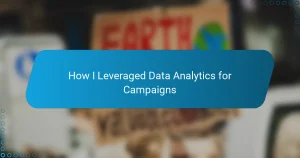Key takeaways
- Localized messaging in swing states focuses on unique voter concerns rather than solely national slogans.
- Ground game efforts, such as door-to-door engagement and local events, are crucial for building personal connections with voters.
- Campaigns invest heavily in swing states, raising concerns about fairness for voters in non-targeted areas.

Strategies for Targeting Swing States
When I think about how campaigns zero in on swing states, the first thing that comes to mind is the intense focus on localized messaging. It’s not just about repeating national slogans but tailoring ads and speeches to the unique concerns of voters in places like Ohio or Florida. Have you ever noticed how a candidate might talk about manufacturing jobs in one state and immigration in another? That kind of targeted messaging feels smart to me because it acknowledges that voters aren’t a monolith.
Another strategy that really stands out is the ground game—the boots on the ground knocking on doors, making phone calls, and hosting local events. From my experience watching past campaigns, these efforts can make or break a race. It’s emotional and personal when a volunteer takes time to engage with a voter face-to-face, and that connection often sticks much more than a commercial on TV.
Does it surprise you how resource-heavy these efforts are? Campaigns pour millions into swing states, running countless ads and organizing endless rallies. While some might see this as strategic brilliance, I sometimes wonder if this intense focus on a few states shortchanges the rest of the country’s voters, raising questions about fairness. But from a practical standpoint, it’s hard to argue with the results swing-state targeting has delivered over the years.


